
Hemidactylus is a genus of the common gecko family, Gekkonidae. It has 195 described species, newfound ones being described every few years. These geckos are found in all the tropical regions of the world, extending into the subtropical parts of Africa and Europe. They excel in colonizing oceanic islands by rafting on flotsam, and are for example found across most of Polynesia. In some archipelagoes, cryptic species complexes are found. Geckos like to live in and out of houses. They have been introduced to Australia.

Gehyra mutilata, also known commonly as the common four-clawed gecko, Pacific gecko, stump-toed gecko, sugar gecko in Indonesia, tender-skinned house gecko, and butiki in Filipino, is a species of lizard in the family Gekkonidae. The species is native to Southeast Asia. It has made its way to several areas of the world including Sri Lanka, Indochina, and many of the Pacific Islands. Compared to the common house gecko, the appearance of G. mutilata is somewhat plump, with delicate skin. The skin is usually colored a soft purplish/pinkish gray, with golden spots on younger specimens; these spots eventually fade with age.

Hemidactylus brookii, also known commonly as Brooke's house gecko and the spotted house gecko, is a widespread species of lizard in the family Gekkonidae.
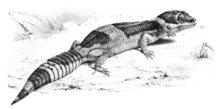
The East Indian leopard gecko, also known commonly as Hardwicke's gecko, is a species of gecko, a lizard in the family Eublepharidae. The species is endemic to India and Bangladesh.

The Indo-Pacific gecko, also known commonly as Garnot's house gecko, fox gecko, and the Assam greyish brown gecko, is a species of lizard in the family Gekkonidae. The species is found in India, across Southeast Asia, Australia, and throughout Polynesia. Adults are about 4 to 5 in in total length. They are seen as dark gray or brown with light markings in daylight and a pale, translucent colour at night. The belly is orange or yellow. The head has a long, narrow snout, hence the name fox gecko. The flattened tail has a row of spiny scales on the lateral edges. The species is parthenogenic – all individuals are female and lay eggs that hatch without requiring male fertilisation.

The Indian golden gecko or Beddome's golden gecko is a species of gecko endemic to the Eastern Ghats of India. It was rediscovered from the hills near present-day Tirupati. The rediscovery was after over 100 years since its description.
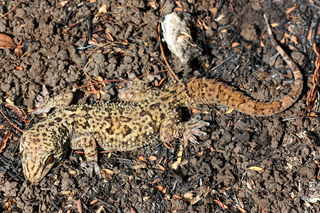
Hemidactylus maculatus, also known as the spotted leaf-toed gecko or giant spotted gecko, is a species of large gecko found in the Western Ghats of India and in parts of Sri Lanka.
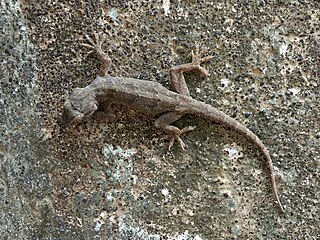
Leschenault's leaf-toed gecko is a species of gecko, a lizard in the family Gekkonidae. The species is endemic to South Asia and parts of West Asia. It is often found inside homes. Its scientific name commemorates French botanist Jean Baptiste Leschenault de la Tour.

The flat-tailed house gecko, also known as the frilled house gecko or Asian house gecko, is a species of Gekkonidae native to southeastern and southern Asia. The species is sometimes classified under the genus Cosymbotus.
Jerdon's day gecko is a species of gecko, a lizard in the family Gekkonidae. The species is native to India and Sri Lanka.
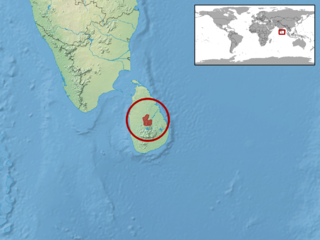
The Kandyan day gecko or Kandyan rock gecko is a species of diurnal gecko found in Sri Lanka.

The Malayan forest gecko or banded bent-toed gecko is a species of gecko found in Southeast Asia.

Lawder's bent-toed gecko is a species of gecko, a lizard in the family Gekkonidae. The species is endemic to northern India. Its type locality is "Kumaon", restricted to Almora by Malcolm Arthur Smith. It is named after Mr. A. Lawder who collected the holotype. His identity is not known for sure, but he is likely to have been A.W. Lawder who was a member of the Geological Society of London, as was Ferdinand Stoliczka who described the species. It is sometimes placed in the genus Cyrtopodion.

Hemidactylus giganteus, also known as the giant leaf-toed gecko, the giant southern tree gecko, or the giant gecko, is a species of gecko endemic to India.
Hemidactylus karenorum, commonly known as the Burmese leaf gecko, the Burmese leaf-toed gecko, and the Burmese spotted gecko, is a species of gecko, a lizard in the family Gekkonidae. The species is endemic to Southeast Asia.

Hemidactylus persicus, also known as the Persian leaf-toed gecko or Persian gecko, is a species of gecko found in West Asia.
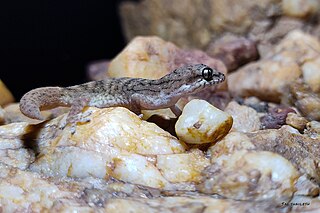
The reticulate leaf-toed gecko is a species of terrestrial, nocturnal, insectivorous gecko found in rocky areas of South India. It takes refuge under stones on ground during day time and emerges out at night for its activities.
Hemidactylus subtriedrus, also known as Jerdon's gecko or Madras blotched gecko, is a species of gecko found in India and Sri Lanka.

Hemidactylus triedrus, also known as the termite hill gecko, Dakota's leaf-toed gecko, or blotched house gecko, is a species of gecko found in South Asia. The race lankae of Sri Lanka, is now given species status and known as Hemidactylus lankae

The Southern Ghats slender gecko is a species of gecko with a restricted distribution in the hills of southern India.


















